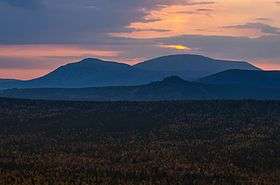Mount Yamantau
| Mount Yamantau | |
|---|---|
 | |
| Highest point | |
| Elevation | 1,640 m (5,380 ft) |
| Coordinates | 54°15′18″N 58°06′07″E / 54.255°N 58.102°E |
| Geography | |
| Location | Republic of Bashkortostan, Russia |
| Parent range | Ural Mountains |
| Mount Yamantaw | |
|---|---|
| Part of Armed Forces of the Russian Federation | |
| Mezhgorye, Republic of Bashkortostan, Russia | |
| Coordinates | 54°15′18″N 58°06′07″E / 54.255°N 58.102°ECoordinates: 54°15′18″N 58°06′07″E / 54.255°N 58.102°E |
| Type | Underground military facility |
| Site information | |
| Controlled by | Armed forces of the Russian Federation |
| Condition | Unknown |
| Site history | |
| Built | Under construction (2003) |
| In use | Unknown |
| Garrison information | |
| Garrison | Mezhgorye |
| Occupants | Unknown |
Mount Yamantau (Bashkir: Ямантау, Russian: гора Ямантау) is in the Ural Mountains, Bashkortostan, Russia. The name means wicked mountain in the Bashkir language (Яман тау). It is also known as Mount Yamantau. It stands at 1,640 metres (5,381 ft) and is the highest mountain in the southern Urals. Along with Kosvinsky Mountain (600 km to the north), it is suspected by the United States of being a large secret nuclear facility and/or bunker as well as being used for communication porposes.[1] The closed military town of Mezhgorye (Russian: Межгорье) is situated nearby. As late as 2003, Yamantaw was not yet fully operational.[1]
Large excavation projects have been observed by U.S. satellite imagery as recently as the late 1990s, during the time of Boris Yeltsin's government after the fall of the Soviet Union.[1] Two garrisons, Beloretsk-15 and Beloretsk-16, were built on top of the facility, and possibly a third, Alkino-2, as well, and became the closed town of Mezhgorye in 1995. They are said to house 30,000 workers each. Repeated U.S. questions have yielded several different responses from the Russian government regarding Mount Yamantaw.[2] They have said it is a mining site, a repository for Russian treasures, a food storage area, and a bunker for leaders in case of nuclear war.[3] Responding to questions regarding Yamantaw in 1996, Russia's Defense Ministry stated: "The practice does not exist in the Defense Ministry of Russia of informing foreign mass media about facilities, whatever they are, that are under construction in the interests of strengthening the security of Russia."[3] Large rail lines serve the facility.[3]
In 1997, a United States Congressional finding, related to the country's National Defense Authorization Act for 1998, stated that the Russian Federation kept up a "deception and denial policy" about the mountain complex after U.S. officials had given Cheyenne Mountain Complex tours to Russian diplomats, which the finding stated "...does not appear to be consistent with the lowering of strategic threats, openness, and cooperation that is the basis of the post-Cold War strategic partnership between the United States and Russia."[4]
See also
References
- 1 2 3 Blair, Bruce G (May 25, 2003). "We Keep Building Nukes For All the Wrong Reasons" (PDF). The Washington Post. Retrieved 28 February 2009.
- ↑ "Yamantau, Beloretsk-15, Beloretsk-16, Alkino-2", Weapons of Mass Destruction, Global Security.
- 1 2 3 Gordon, Michael R. (April 16, 1996). "Despite Cold War's End, Russia Keeps Building a Secret Complex". The New York Times. Retrieved 28 February 2009.
- ↑ PROVIDING FOR CONSIDERATION OF H.R. 1119, NATIONAL DEFENSE AUTHORIZATION ACT FOR FISCAL YEAR 1998 (House of Representatives - June 19, 1997